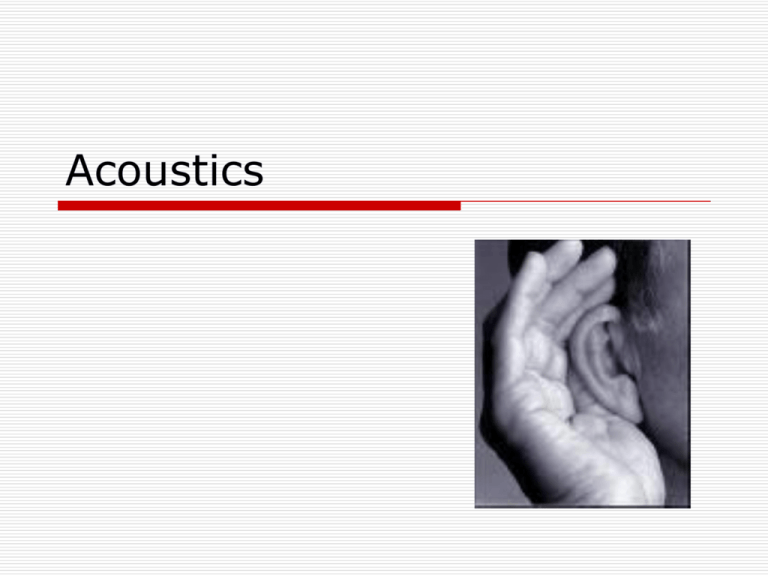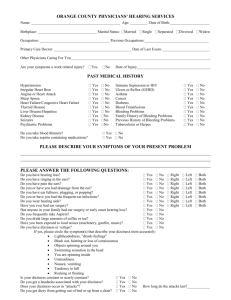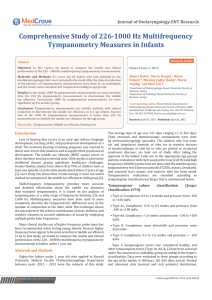Tympanometry
advertisement

Acoustics Sound mechanical oscillation 20Hz - 20kHz – audible sound 0,7Hz - 20Hz – infrasound 20kHz – hundreds of MHz - ultrasound Speed of sound E … Young’s modulus of elasticity (stell cca 5100 m/s) K … volume stress modulus (water cca 1500 m/s) Rychlost šíření zvuku Ambient Speed of sound c (m/s) Air 0°C 332 Air 20°C 344 Hydrogen 1270 Water 13°C 1441 Water 20°C 1484 Ice 0°C 3200 Rubber 1440 Steel 5000 Glass 6000 Speed of sound in air Effect of temperature tempetarute [°C] ρ in kg·m-3 c in m·s-1 Z in N·s·m-3 −10 325.2 1.342 436.1 −5 328.3 1.317 432.0 0 331.3 1.292 428.4 5 334.3 1.269 424.3 10 337.3 1.247 420.6 15 340.3 1.225 416.8 20 343.2 1.204 413.2 25 346.1 1.184 409.8 30 349.0 1.165 406.3 Acoustic particle displacement, speed and pressure a = amax.sin (ω.t) = amax.sin (2π.f.t) v = da/dt = amax.2π.f.cos (2π.f.t) = vmax.cos (2π.f.t) pmax = ρ.c.vmax Total pressure in one point: atmopheric pressure + acoustic pressure Efective acoustic speed and pressure vef = vmax/√2 pef = pmax/√2 pef = ρ.c.vef Acoustic impedance Analogy to el. parameters: Z = Uef/Ief => Z = pef/vef Z=c.ρ Acoustic impedance is characteristic parameter for Each ambient and affects quantum of acoustic energy rebounded on transition between two ambient with different acoustic impedance. Sound intensity I = P/S [W/m2] I = ½ . pmax.vmax = ½ . vmax2.ρ.c = ½ . pmax2/(ρ.c) I = pef.vef = vef2.ρ.c = pef2/(ρ.c) Io = 10-12 W/m2 Sound intensity level L(B)=log (I/Io) [B] L(dB) = 10.log (I/Io) [dB] L(dB) = 10.log (I/Io) = 10.log (pef/po)2 = = 20.log (pef/po) p0 = 2.10-5 Pa Acoustic pressure in sound Source of sound Theoretical limit for undistorted sound at Sound pressure Sound pressure level[6] pascal dB re 20 μPa 101,325 Pa 194.0937 dB Krakatoa explosion at 100 miles (160 km) in air 20,000 Pa [2] 180 dB Simple open-ended thermoacoustic device [7] 12,000 Pa 176 dB 5,000 Pa 168 dB Jet engine at 30 m 630 Pa 150 dB Rifle being fired at 1 m 200 Pa 140 dB Threshold of pain 100 Pa 130 dB 20 Pa approx. 120 dB 6 – 200 Pa 110 – 140 dB 2 Pa approx. 100 dB 6×10−1 Pa approx. 85 dB Major road at 10 m 2×10−1 – 6×10−1 Pa 80 – 90 dB Passenger car at 10 m 2×10−2 – 2×10−1 Pa 60 – 80 dB 2×10−2 Pa approx. 60 dB Normal talking at 1 m 2×10−3 – 2×10−2 Pa 40 – 60 dB Very calm room 2×10−4 – 6×10−4 Pa 20 – 30 dB Leaves rustling, calm breathing 6×10−5 Pa 10 dB Auditory threshold at 2 kHz 2×10−5 Pa 0 dB M1 Garand being fired at 1 m Hearing damage (due to short-term exposure) Jet at 100 m Jack hammer at 1 m Hearing damage (due to long-term exposure) TV (set at home level) at 1 m Ear Outer ear Lobe – gristle (direction of acoustic oscillation to ear canal) Ear canal – gristle and bone, 3cm (sound -> tymapnum) Ear drum – tissue membrane, 0,1mm Middle ear Air filled antrum Earbones Malleus Ambos Stapes Eustachian tube – pressure balancing Internal ear Cochlea– liquid filled Corti’s organ Hair cells Audible nerve Auditory field Loudness level Weighted filters Hearing disorders Conductive hearing Otitis Otosclerosis Sensorineural loss Menier’s disease Neurinom Diagnostics methodes Audiometry Kochlear reserve Tone audiometry: conductive hearing on right side Tone audiometry: sensorineural loss on left side Kochlear reserve Tone audiometry: mixed loss on left side Diagnostics methods Tympanometry Diagnostic of middle ear Umožňuje vyšetřit: Reflexies: m.stapedius m.tensor tympani Decay test Volume: ear canal (only with undemaged ear drum) ear canal and mastoideal chambers ( perforated ear drum) Tympanometry: curve A = physiological status Tympanometry: curve C = dysfunction of ET Tympanometry: curve B = high rigidity (liquid in middle ear – myringosclerosis…) Diagnostics methods Otoacoustic emission Spontaneous (SOAEs) Evoke (tone, broad frequency spectrum) For internal ear For newborn Hearing compensation Hearing aid Hearing compensation Cochlear neuroprotesis Microfon Speech processor Transmitter Receiver Stimulator Electrodes





